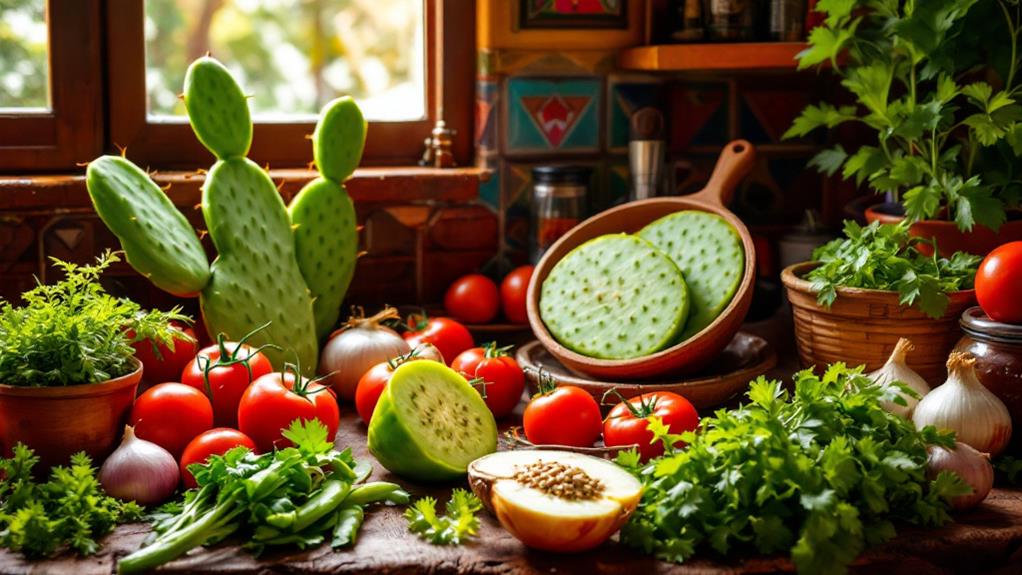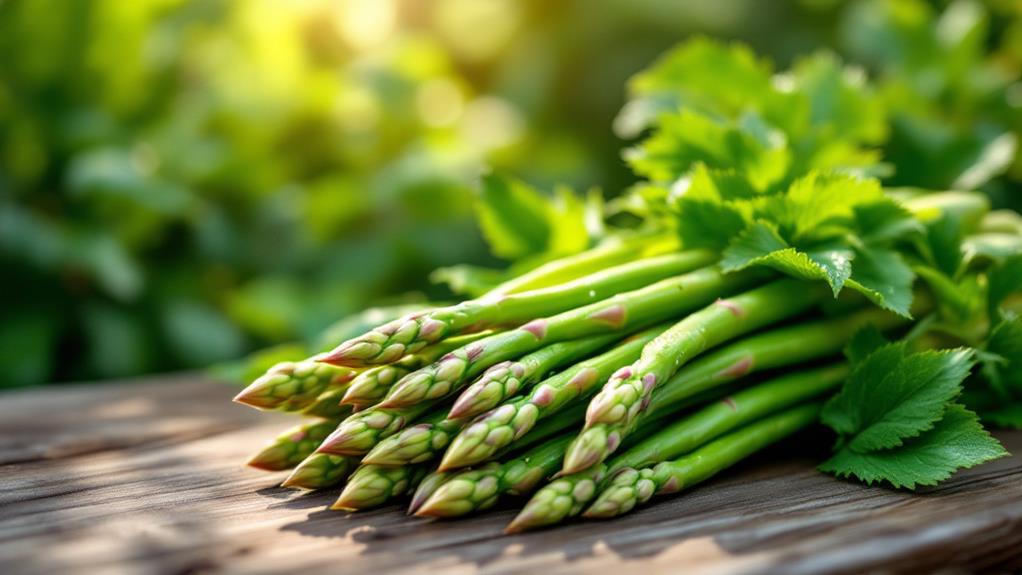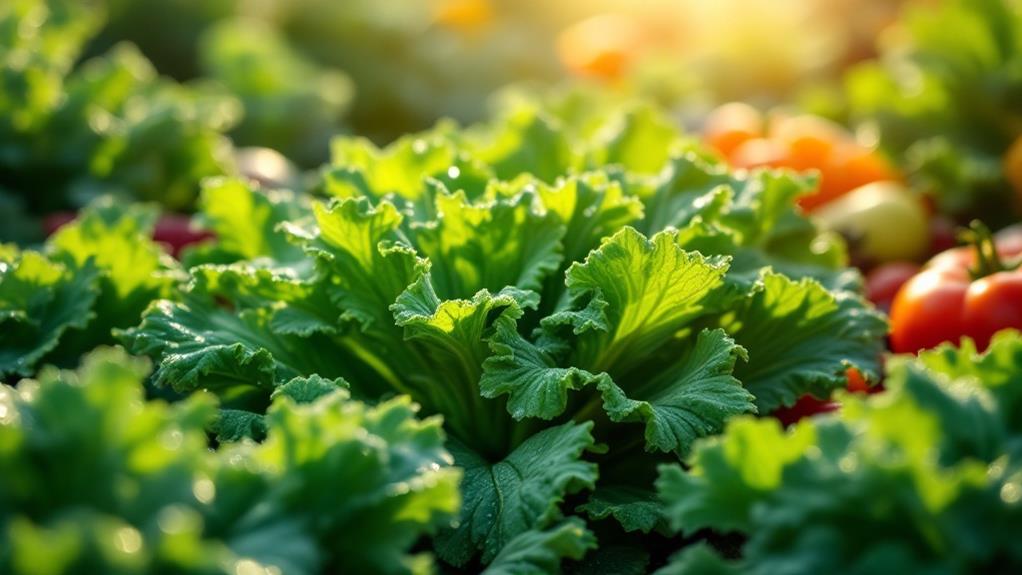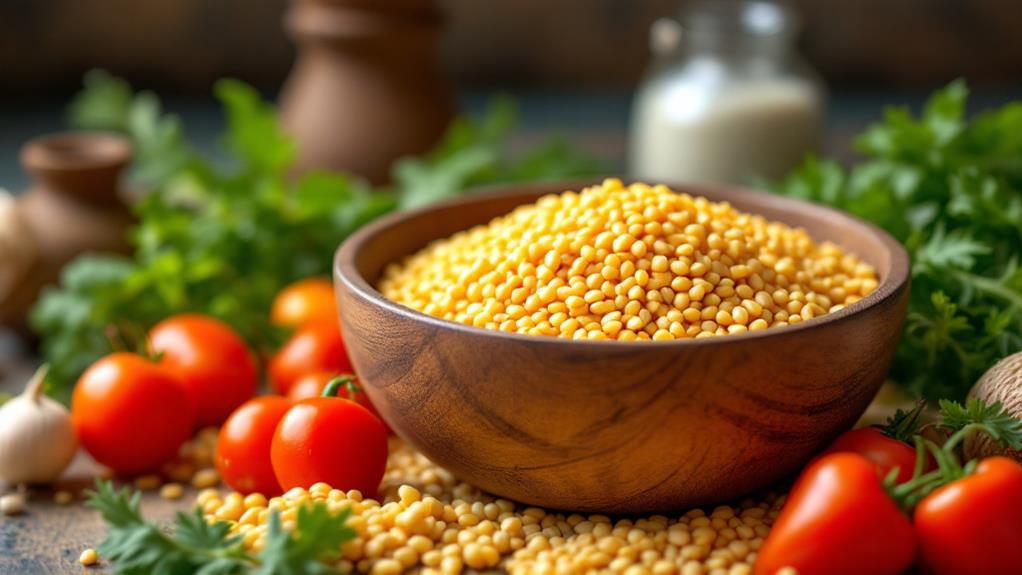The Ultimate Guide to the Types and Benefits of Cabbage
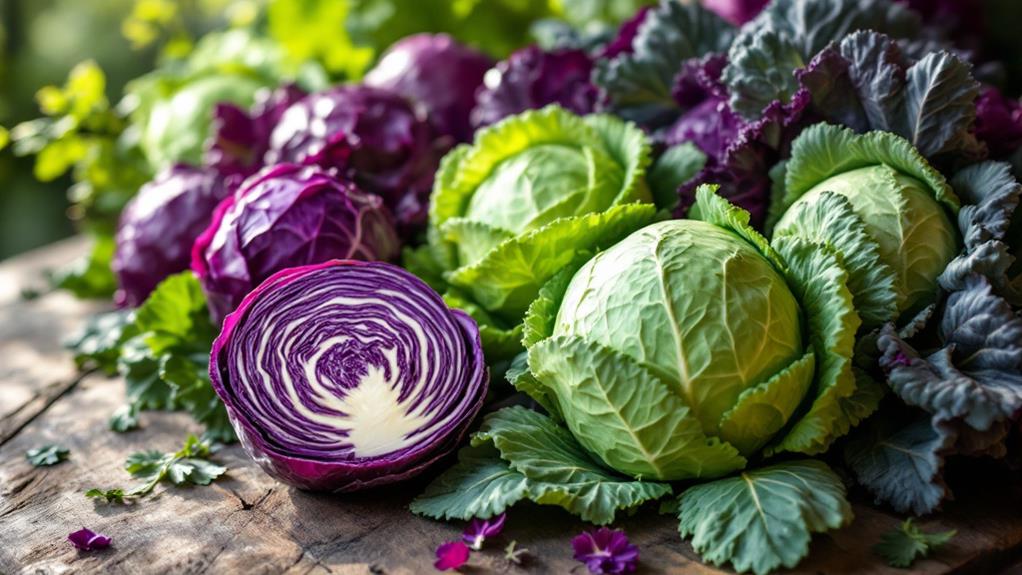
Investigate the world of cabbage and uncover its diverse types and impressive benefits. White cabbage varieties like green and jaroma are packed with vitamins C and K. Lively options such as red and savoy cabbage feature antioxidant properties, ideal for salads and stews. Asian varieties like napa and bok choy offer mild flavors and crunch, rich in vitamins A, C, and K. Cabbage is low in calories, high in fiber, and supports digestive health. It's versatile enough for sautéing, steaming, or even raw consumption. Reveal how cabbage can enrich your meals and enhance your health in delightful ways.
White Cabbage Varieties
When exploring the world of white cabbage varieties, you'll find a range of options that each bring something unique to the table. Commonly referred to as green cabbage, white cabbage is a nutrient-rich powerhouse packed with vitamins C and K. It's not just a staple in dishes like sauerkraut and coleslaw but also offers numerous health benefits, aiding in enhancing immunity and supporting bone health.
Among the varieties, pointed cabbage stands out with its slightly sweet flavor and tender leaves. It's perfect for those quick meals, as it's best used within three days of purchase. Then there's Jaroma cabbage, characterized by its flattened shape and less bitter taste. Its tender leaves cook quickly and are easy to digest, making it a great option for fast meals.
White cabbage is versatile and long-lasting, with a shelf life of 1-2 months in the refrigerator and up to six months when frozen. You can sauté, steam, or simmer it in soups to enjoy its mild flavor. Pair it with spices like caraway seeds for an extra kick, and you've got a delightful, healthy dish ready to go.
Colorful Cabbage Varieties
While white cabbage certainly holds its own with its versatility and nutritional benefits, the world of colorful cabbage varieties offers a likewise impressive array of options to investigate. Red cabbage stands out with its radiant violet hue and impressive health benefits. It's packed with vitamin C and antioxidants, giving you a full daily dose of vitamin C in just 100g, bolstering your immune system. Its color changes based on cooking ingredients, turning bluish with sweet ingredients and reddish with acidic ones, adding a unique visual twist to your dishes.
Savoy cabbage, with its frilly, delicate leaves, is another colorful option worth exploring. It's high in vitamins C, A, and B6, making it a nutritious choice for your meals. Regardless of whether you prefer it raw in salads or cooked in stews, its texture and flavor are perfect for numerous culinary applications, even gracing fine dining tables.
Both red and savoy cabbages not only elevate the visual appeal of your dishes but also offer numerous health benefits. They're anti-inflammatory and support heart health, making them excellent choices for a health-conscious diet. Try incorporating them into salads, stir-fries, or as quiche fillings.
Asian Cabbage Varieties
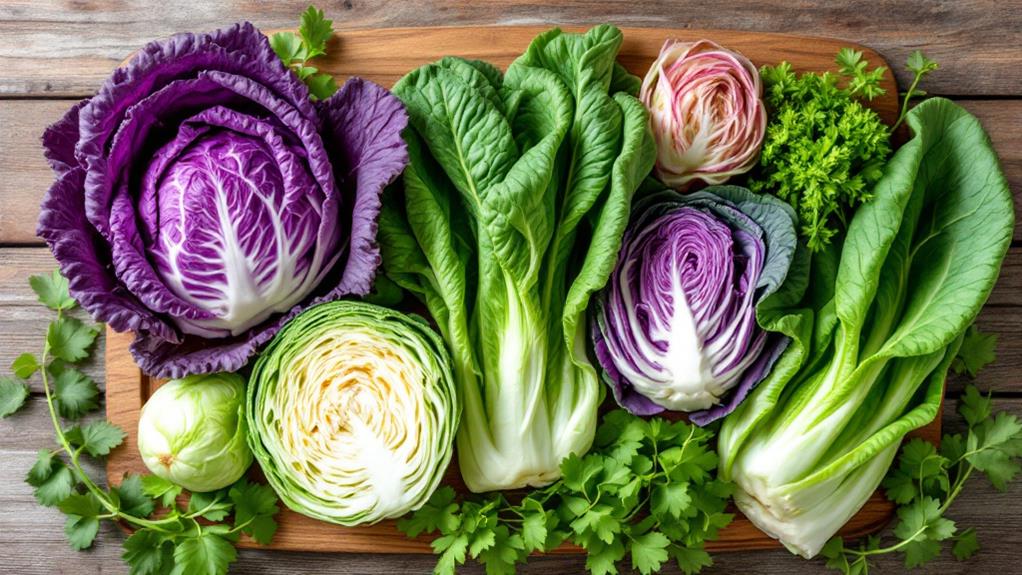
Among the diverse range of cabbages, Asian varieties stand out with their unique flavors and nutritional benefits. If you're looking to investigate new tastes, Asian cabbages like Napa Cabbage, Bok Choy, and Tat Soi should be on your list. Napa Cabbage, also known as Chinese cabbage, is a staple in Asian cuisines. Its elongated, crinkled leaves contribute a mild flavor to dishes like kimchi and stir-fries, while packing a punch with vitamins C and K.
Bok Choy is another popular choice. With its crisp, green leaves and white base, it's perfect for stir-fries and soups. It's low in calories but rich in vitamins A, C, and K, making it a healthy enhancement to your meals. Tat Soi, with its dark green, spoon-shaped leaves, offers a mild taste suitable for salads and soups. It's packed with vitamins and antioxidants.
Here's a quick guide to these Asian cabbage varieties:
- Napa Cabbage: Mild flavor, rich in vitamins C and K
- Bok Choy: Crisp texture, high in vitamins A, C, and K
- Tat Soi: Mild taste, antioxidant-rich
- Choy Sum: Mild flavor, crunchy texture
- Mizuna: Peppery taste, high in vitamins A and C
Investigate these varieties and boost your dishes today!
Brassica Vegetables
As you investigate nutritious food options, Brassica vegetables should be a top consideration due to their exceptional health benefits and versatility. Part of the Brassica genus, these vegetables include cabbage, broccoli, and others. They're rich in vitamins C and K, fiber, and powerful antioxidants. These nutrients play a critical role in promoting your overall well-being.
One standout feature of Brassica vegetables is their glucosinolate content. These compounds are linked to a lower cancer risk and may help reduce inflammation and oxidative stress in your body. This makes them an excellent supplement to a health-conscious diet. Despite being low in calories, they provide crucial nutrients, supporting weight management and healthy eating goals.
Incorporating Brassica vegetables into your meals is easy due to their versatility. You can enjoy them raw in salads, or cook them in stir-fries. They're also perfect for fermentation into probiotic-rich foods like sauerkraut and kimchi.
Regular consumption of these vegetables is associated with numerous health benefits. They can improve your digestive and heart health and might even offer cancer-fighting properties. So, why not make Brassica vegetables a staple in your diet?
Brussels Sprouts Inspirations
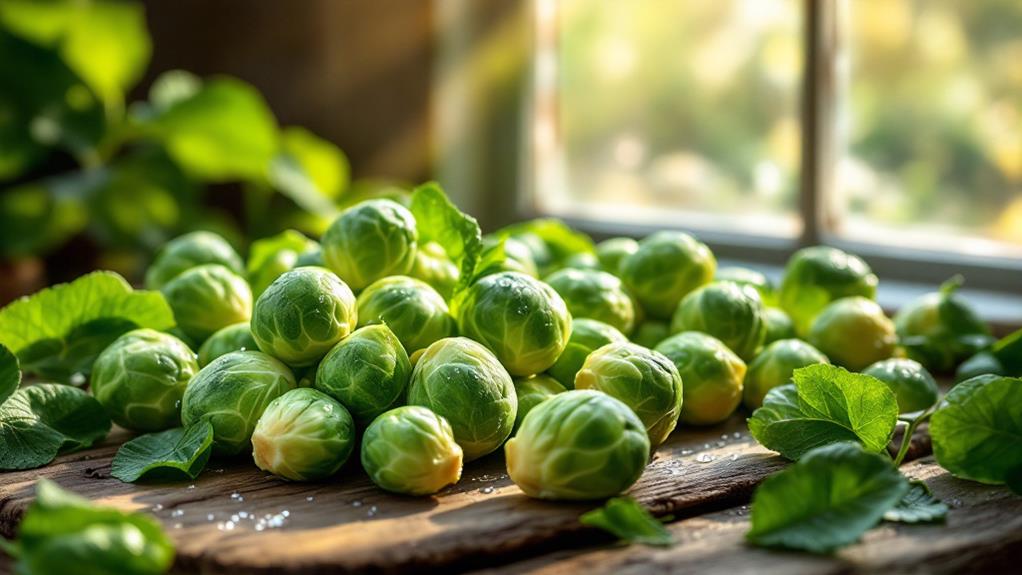
Brussels sprouts are another fantastic member of the Brassica family you should consider adding to your meals. They're incredibly nutritious, packing a punch with vitamins C and K—just one cup gives you more than 100% of your daily vitamin K needs. These mini cabbages are not only delicious but also high in fiber, supporting digestive health and helping you feel full, which can aid in maintaining a healthy weight. Plus, they contain glucosinolates, compounds that may offer cancer-fighting properties, making them a powerhouse vegetable.
When it comes to preparation, Brussels sprouts shine brightest when roasted or sautéed. These cooking methods amplify their natural sweetness, creating a delightful side dish perfect for holiday meals. But don't stop there—they're versatile enough to be enjoyed in a variety of ways. Consider these ideas:
- Roast them with a drizzle of olive oil and a sprinkle of sea salt.
- Sauté with garlic and balsamic glaze for a flavorful twist.
- Shave them raw into salads for a crunchy texture.
- Toss them with pasta for a nutritious main dish.
- Bake into casseroles for a comforting meal.
Explore these Brussels sprouts inspirations and boost your culinary repertoire!
Unique Brassica Recipes
Investigate a world of culinary creativity with these unique Brassica recipes that transform simple vegetables into standout dishes. Start with Romanesco Pancakes with Herb Dip, where the visually striking Romanesco combines a crispy texture with a flavorful dip. This dish not only looks stunning but also makes you appreciate the beauty and taste of seasonal, highly nutritious vegetables.
Next, try the Brussels Sprout Pasta Carbonara for a modern twist on a classic. Fried Brussels sprouts add a buttery flavor, instantly elevating your pasta experience. It's a delicious way to enjoy this cabbage variety while indulging in comfort food.
For a delightful brunch option, the Savoy Cabbage Quiche is perfect. The tender, frilly leaves of Savoy cabbage blend seamlessly with the other quiche ingredients, offering a satisfying mix of flavors and textures. It's an excellent way to showcase the diversity of cabbage varieties.
Broccoli Delights
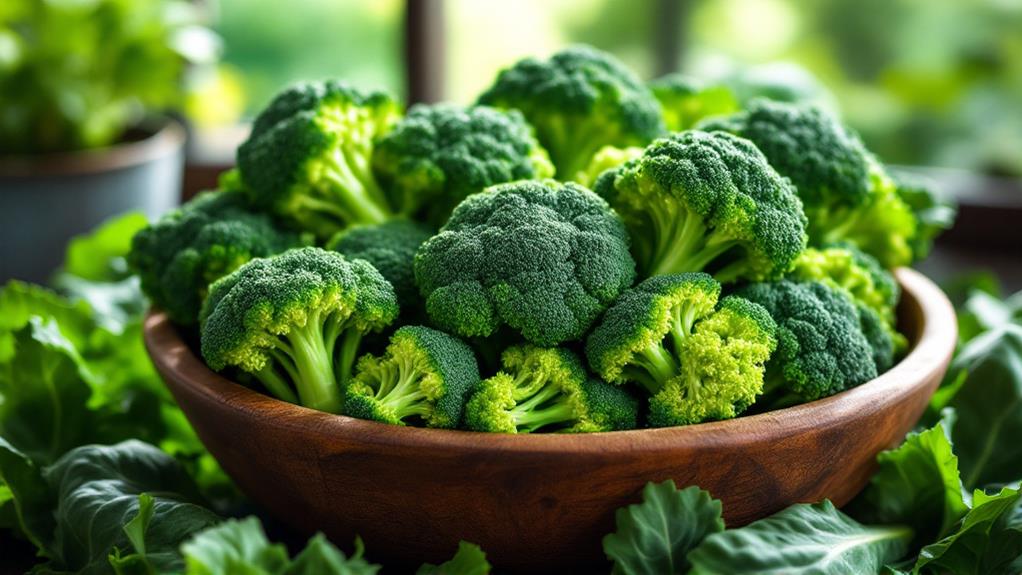
Broccoli's versatility and nutrient density make it a true delight in any kitchen. This lively vegetable is a nutrient powerhouse, loaded with vitamin C, calcium, carotene, and magnesium. Regardless of your feelings towards cabbage, you'll appreciate broccoli's unique flavor, akin to asparagus, which makes it a standout choice for many. You can use both the stalks and florets, creating endless possibilities in your culinary endeavors. From stir-fries to salads, broccoli seamlessly adapts, offering a satisfying crunch and rich taste.
Cooking broccoli is a breeze, typically taking around 30 minutes. Its ability to retain both texture and flavor when properly prepared makes it a favorite among health-conscious cooks. Beyond its taste, broccoli is bursting with health benefits, including cancer risk reduction and immune system support, thanks to its high antioxidant content.
Here's why broccoli delights:
- Nutrient-rich: Packed with crucial vitamins and minerals.
- Culinary flexibility: Perfect for a range of dishes.
- Flavorful: Appeals even to those not fond of cabbage.
- Quick cooking: Ready in just about 30 minutes.
- Health benefits: Supports cancer prevention and immunity.
Embrace the wonders of broccoli in your daily meals, and enjoy its delightful contributions to your health and palate.
Nutritional Benefits of Cabbage
As we've celebrated broccoli for its versatility and health benefits, it's time to shine a light on another member of the brassica family: cabbage. This humble vegetable packs a punch with its impressive nutritional profile. One of cabbage's standout features is that it's low in calories, containing just 17 calories per half-cup cooked. This makes it an excellent choice for those looking to manage their weight without sacrificing flavor or nutrition.
Cabbage is rich in vitamin C, with a half-cup serving providing 30-35% of your daily requirement. This vital nutrient supports immune health and aids in skin repair, keeping you healthy and glowing. Furthermore, cabbage is a great source of vitamin K, offering 81.5 micrograms per half-cup. Vitamin K is vital for blood clotting and maintaining strong bones.
The high fiber content in cabbage aids digestion, promotes regular bowel movements, and supports the growth of beneficial gut bacteria. This can lead to better general digestive health. In addition, cabbage contains powerful antioxidants, like sulforaphane and flavonoids. These compounds help reduce chronic inflammation and may lower the risk of certain cancers, making cabbage a valuable enhancement to your diet.

